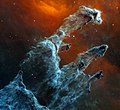ファイル:Pillars of creation - JWST, MIRI - STScI-01GFRYYRTCTMX197BY86MBFCR9.png
表示

このプレビューのサイズ: 656 × 600 ピクセル。 その他の解像度: 263 × 240 ピクセル | 525 × 480 ピクセル | 840 × 768 ピクセル | 1,120 × 1,024 ピクセル | 1,987 × 1,817 ピクセル。
元のファイル (1,987 × 1,817 ピクセル、ファイルサイズ: 4.06メガバイト、MIME タイプ: image/png)
ファイルの履歴
過去の版のファイルを表示するには、その版の日時をクリックしてください。
| 日付と時刻 | サムネイル | 寸法 | 利用者 | コメント | |
|---|---|---|---|---|---|
| 現在の版 | 2022年10月29日 (土) 21:06 |  | 1,987 × 1,817 (4.06メガバイト) | Fabian RRRR | Uploaded a work by Credits: SCIENCE: NASA, ESA, CSA, STScI IMAGE PROCESSING: Joseph DePasquale (STScI), Alyssa Pagan (STScI) from https://webbtelescope.org/contents/media/images/2022/053/01GFRYSFM89AFADVAA0W625BSB with UploadWizard |
ファイルの使用状況
以下のページがこのファイルを使用しています:
グローバルなファイル使用状況
以下に挙げる他のウィキがこの画像を使っています:
- da.wikipedia.org での使用状況
- de.wikipedia.org での使用状況
- en.wikipedia.org での使用状況
- es.wikipedia.org での使用状況
- fr.wikipedia.org での使用状況
- Discussion utilisateur:O. Morand
- Discussion utilisateur:Padawane
- Discussion utilisateur:L'amateur d'aéroplanes
- Discussion utilisateur:Sammyday
- Discussion utilisateur:Oziris
- Discussion utilisateur:Pautard
- Discussion utilisateur:Ghoster
- Discussion utilisateur:Hadrianus
- Discussion utilisateur:GabrieL
- Discussion utilisateur:Borvan53
- Discussion utilisateur:Theoliane
- Discussion utilisateur:Abalg
- Discussion utilisateur:Michel421
- Discussion utilisateur:Kimdime
- Discussion utilisateur:Cantons-de-l'Est
- Discussion utilisateur:A1AA1A
- Discussion utilisateur:Hégésippe Cormier
- Discussion utilisateur:Erik Bovin
- Discussion utilisatrice:Manacore
- Discussion utilisatrice:Gráinne Ni Mháille
- Discussion utilisateur:K.A
- Discussion utilisateur:Skimel
- Discussion utilisateur:ContributorQ
- Discussion utilisateur:Mandariine
- Discussion utilisateur:Bertrouf
- Discussion utilisateur:O-R/Archive
- Discussion utilisateur:Lagribouille
- Discussion utilisateur:Jean-Paul Corlin
- Discussion utilisateur:Tylwyth Eldar
- Discussion utilisateur:Starus
- Discussion utilisateur:Sunrise156
- Discussion utilisateur:O.Taris
- Discussion utilisateur:Ælfgar/6649
- Discussion utilisateur:Sernin seb-calmetaf
- Discussion utilisateur:Bounè rodzo
- Discussion utilisateur:Goodshort
- Discussion utilisateur:Polmars
- Discussion utilisateur:BerwaldBis
- Discussion utilisateur:GrandCelinien
- Discussion utilisateur:Olivier Tanguy
- Discussion utilisateur:Jack Rabbit Slim's
- Discussion utilisateur:Io Herodotus/Archive 2021-2023
- Discussion utilisateur:Julien1978/Archive 7
- Discussion utilisatrice:Esprit Fugace/Archive22
- Discussion utilisateur:Harrieta171/1
- Discussion utilisateur:SenseiAC
このファイルのグローバル使用状況を表示する。




